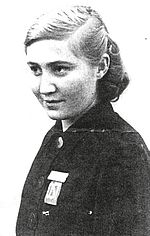Who wants to live, risks life
Disciplining through Terror
The surveillance, disciplining and terrorization of the forced laborers were among the main tasks of the police, the Gestapo and the judiciary, along with the persecution of the German resistance and the murder of the European Jews.
The security authorities spent immense institutional and personnel resources on monitoring the forced laborers. In the nine months from January to September 1943 alone, the Gestapo arrested 260,000 forced laborers. Even any suspicion of sabotage or theft, refusal to work, resistance, "gang formation" or forbidden contact between German women and forced laborers was severely punished: by imprisonment in prisons, Gestapo labor camps and concentration camps, or by judgement of one of the many "special courts", which were supposed to make a "short trial" in summary proceedings.
In many cases they imposed the death penalty - increasingly also against Western Europeans at the end of the war. The Gestapo itself punished crimes committed by Eastern Europeans and Poles within the framework of "special treatment" (execution without sentence).
Many companies made themselves the henchmen of this terror system: not only by imposing "minor" punishments themselves. They also reported "conspicuous" forced labourers to the police, which meant that they were first thrown into the mills of the police, the Gestapo and the judiciary.


